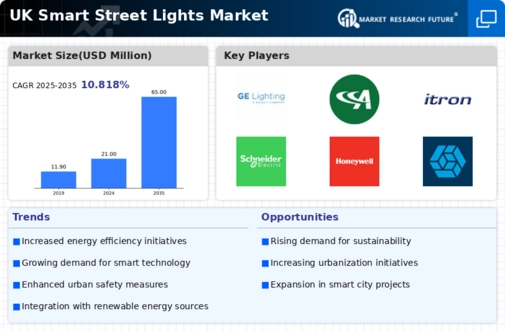Public Safety and Crime Reduction
Public safety remains a paramount concern for urban planners and local authorities in the UK. The smart street-lights market is increasingly recognized for its potential to enhance safety in public spaces. Well-lit streets can deter criminal activity and improve the overall perception of safety among residents. Moreover, smart street-lighting systems can be equipped with sensors and cameras to monitor public areas, providing valuable data for law enforcement. This capability not only aids in crime reduction but also fosters community trust. As a result, the demand for smart street-lighting solutions is likely to rise, as municipalities prioritize public safety in their urban development strategies.
Environmental Sustainability Goals
The push for environmental sustainability is a key factor influencing the smart street-lights market. Local governments in the UK are increasingly focused on reducing carbon footprints and promoting green initiatives. Smart street-lighting systems, which often utilize energy-efficient technologies, align with these sustainability goals. For example, the transition to LED lighting can lead to a reduction in energy consumption by up to 50%. Additionally, smart street lights can be integrated with renewable energy sources, further enhancing their environmental benefits. As cities strive to meet sustainability targets, the smart street-lights market is expected to grow, driven by the need for eco-friendly urban solutions.
Government Initiatives and Funding
The UK government actively promotes the adoption of smart street-lights through various initiatives and funding programs. This support is crucial for the smart street-lights market, as it encourages local authorities to invest in advanced lighting solutions. For instance, the UK government has allocated substantial budgets for smart city projects, which include smart street-lighting systems. This funding not only aids in the initial setup costs but also facilitates ongoing maintenance and upgrades. As a result, The smart street-lights market is likely to grow due to these governmental efforts aimed at enhancing urban infrastructure and improving public safety.
Technological Advancements in Lighting
Rapid technological advancements in lighting solutions are significantly impacting the smart street-lights market. Innovations such as LED technology, IoT integration, and adaptive lighting systems are becoming increasingly prevalent. The shift towards LED street lights, which consume up to 75% less energy than traditional lighting, is particularly noteworthy. Furthermore, the integration of IoT allows for real-time monitoring and data collection, enhancing operational efficiency. These technological improvements not only reduce energy costs but also extend the lifespan of lighting systems, making them more appealing to municipalities. Consequently, the smart street-lights market is poised for expansion as cities seek to modernize their lighting infrastructure.
Growing Urbanization and Population Density
The ongoing trend of urbanization in the UK is a significant driver for the smart street-lights market. As cities expand and population density increases, the demand for efficient and effective street lighting becomes more pronounced. Urban areas require advanced lighting solutions to ensure safety and visibility, particularly in high-traffic zones. The smart street-lights market is likely to benefit from this trend, as municipalities seek to implement systems that can adapt to changing urban environments. Moreover, the integration of smart technologies can help manage energy consumption, which is crucial in densely populated areas where energy demands are high.






















Leave a Comment